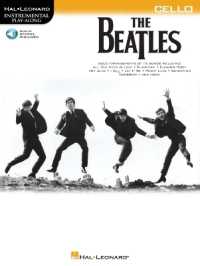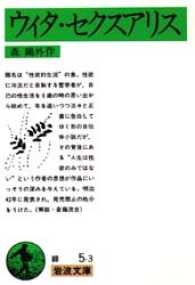- ホーム
- > 洋書
- > 英文書
- > Psychology
Full Description
'Bullets don't just travel through skin and bone. They travel through time.'
These words were tattooed onto the shoulder of a young woman whose father was shot during "The Troubles" in Northern Ireland. This wrenching, volatile but also binding truth is the subject of this book. It's a truth about traumatic experiences that happen to a family, but also to a society, and to the organizations that link these intimate units with the larger context of history and culture. It's also a truth about the way trauma plays out over time, including between generations.
Grounded in Erik Erikson's "way of looking at things", the book is a journal of encounters between clinical psychoanalysis and other disciplines, and an inquiry into what might be learned there for both. Sometimes that learning has to do with trauma: the way in which what can't be emotionally contained, thought about or spoken in one part of a system is passed along, with disorganizing, sometimes heartbreaking consequences, to another.
After a reflection on dignity, the book examines intergenerational trauma in families, including Erikson's. It then illustrates how trauma to organizations slips below the threshold of awareness and yet continues to wear down its members. The final section examines aspects of the larger society, including radicalization, war trauma, the pandemic and cultural healing. What emerges is the sober yet hopeful truth that what people discover by taking their own emotional experiences seriously, though that might markedly differ from what is accepted in the everyday world, is a primary path toward recovery from trauma.
Contents
Acknowledgments
Permissions
About the author
Introduction
Prologue
Of Whom Shall We Speak: Psychoanalysis and Dignity
Part I: Trauma in Families
Chapter 1 - Fear of Breakthrough: The Transmission of Trauma
Chapter 2 - Walking into the Wild: Traumatic Disillusionment and Identity Crisis
Chapter 3 - A Way of Looking at Trauma: Erik Erikson and the "Cogwheeling" of Life Cycles
Part II: Trauma in Organizations
Chapter 4 - Minding the Gap: The Problem of College Suicide
Chapter 5 - Potential Space and Organizational Trauma
Chapter 6 - On the Mantelpiece: Organizational Trauma in Plain Sight
Part III: Trauma in Society
Chapter 7 - National Nightmare: The Legacy of Perpetrator Trauma
Chapter 8 - The Cure for Depression is Jihad: A Case Study
Chapter 9 - Sky of Tears: Clinical Work after 9/11
Chapter 10 - The Day I Died: Combat Trauma and Moral Injury
Chapter 11 - We Don't Speak of Fear: Large Group Identity and Chosen Trauma
Chapter 12 - The Stones Speak: Historical Trauma and Cultural Healing
Chapter 13 - Traveling through Time: A Group Intervention in Northern Ireland
Afterword - When There Are So Many: Two Moments during the Pandemic
Epilogue - Anna Freud's Drapes
References
Index








